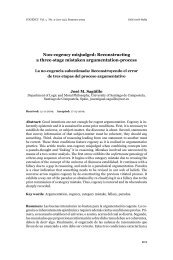Cogency v2 n2
Cogency v2 n2
Cogency v2 n2
Create successful ePaper yourself
Turn your PDF publications into a flip-book with our unique Google optimized e-Paper software.
Dialogue-in-process. Review of Frans H. van Eemeren and... / S. GRECO MORASSO<br />
proaches are critically revisited and integrated in an original and consistent<br />
analysis.<br />
4. Semantics and the evaluation of argumentative discourse<br />
In my opinion, the role of an accurate semantic analysis in the evaluation of<br />
argumentative practices is of particular significance. I am taking up various<br />
authors’ suggestion in this respect, since many of them are – more or less<br />
directly – making use of instruments from linguistic semantics to complete<br />
their analyses in different respects.<br />
Following an observation by Aristotle, Rigotti (Ch. 12) remarks that “a<br />
fine semantic analysis is in every case useful to apply as a preliminary treatment<br />
of the statements that are involved in the argumentative procedures,<br />
in order to avoid polysemies and other sources of fallacies”. Jaquette (Ch.<br />
8) is of the same opinion, since he makes uses of semantic analysis to discover<br />
a fallacy. The reasoning he examines, which was proposed by Burleigh<br />
in the Middle Ages, is the following:<br />
“I say that you are an ass; therefore I say that you are an animal.<br />
I say that you are an animal; therefore, I say the truth.<br />
I say that you are an ass; therefore, I say the truth”.<br />
It is evident that the conclusion does not deductively follow from the<br />
premises but, at first sight, it might not be clear why. For this reason, such<br />
reasoning claims to threaten logic; yet it is, as the author shows, logically<br />
invalid (p. 111) because of the semantics of the terms used here. As the author<br />
puts it: “Hypothetical syllogism is deductively valid only insofar as it<br />
involves not merely uniform ‘syntactical’ terms loosely adapted from ordinary<br />
language, but only referentially univocal terms that designate precisely<br />
the same objects or properties” (p. 113). In this case, Jaquette identifies the<br />
source of ambiguity in the phase “to be an animal”. On this point, his analysis<br />
could be refined by translating Burleigh’s asinine fallacy into an equivalent<br />
but different one. Let us imagine we refer to a German citizen and comment:<br />
“I say that you are Italian; therefore, I say that you are European. I<br />
say that you are European; therefore, I say the truth. I say that you are Ital-<br />
185








